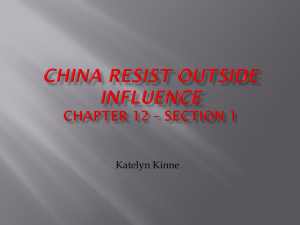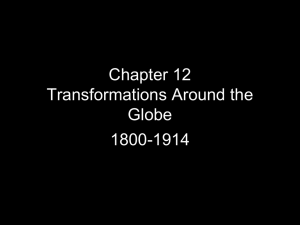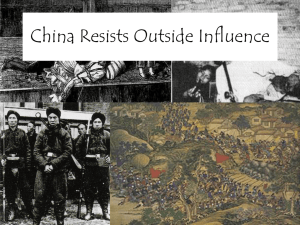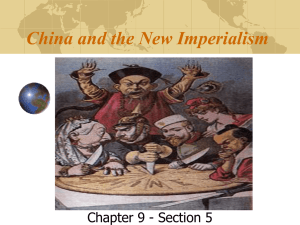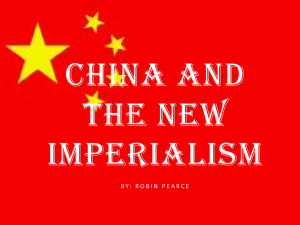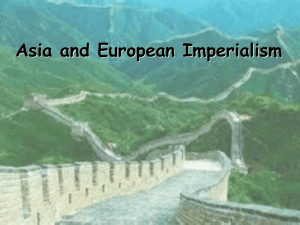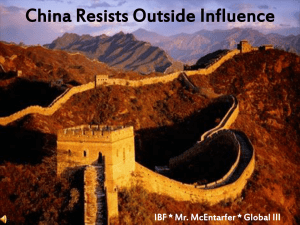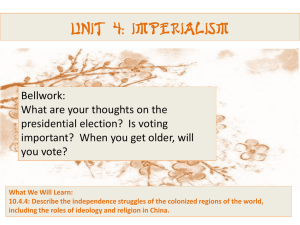China sources
advertisement
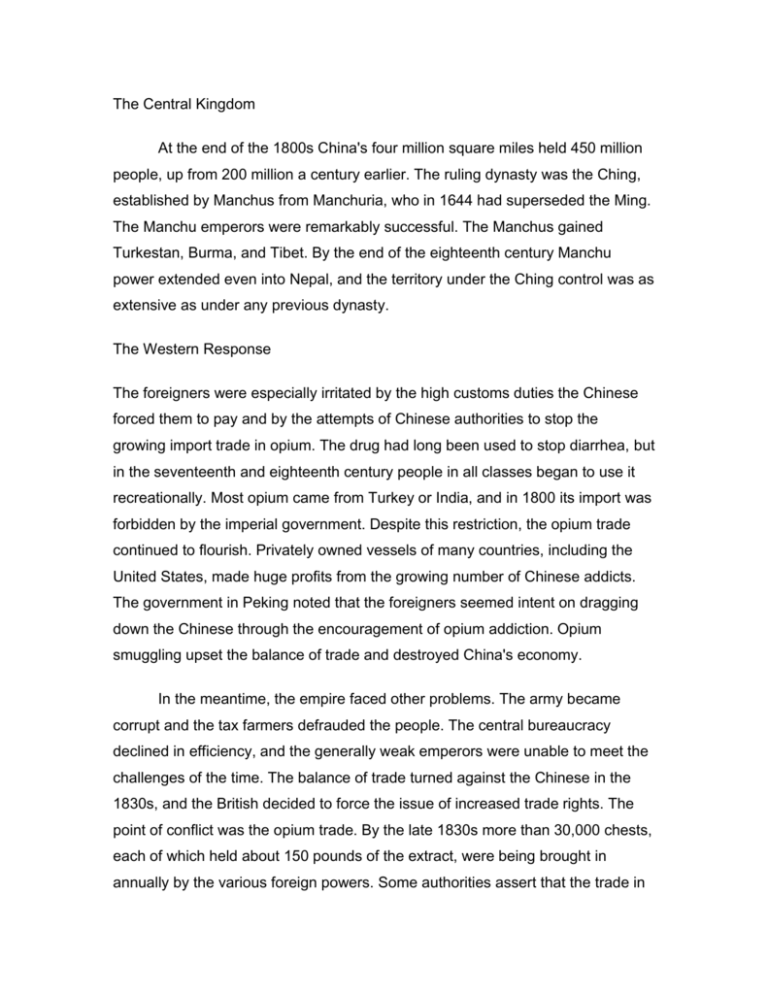
The Central Kingdom At the end of the 1800s China's four million square miles held 450 million people, up from 200 million a century earlier. The ruling dynasty was the Ching, established by Manchus from Manchuria, who in 1644 had superseded the Ming. The Manchu emperors were remarkably successful. The Manchus gained Turkestan, Burma, and Tibet. By the end of the eighteenth century Manchu power extended even into Nepal, and the territory under the Ching control was as extensive as under any previous dynasty. The Western Response The foreigners were especially irritated by the high customs duties the Chinese forced them to pay and by the attempts of Chinese authorities to stop the growing import trade in opium. The drug had long been used to stop diarrhea, but in the seventeenth and eighteenth century people in all classes began to use it recreationally. Most opium came from Turkey or India, and in 1800 its import was forbidden by the imperial government. Despite this restriction, the opium trade continued to flourish. Privately owned vessels of many countries, including the United States, made huge profits from the growing number of Chinese addicts. The government in Peking noted that the foreigners seemed intent on dragging down the Chinese through the encouragement of opium addiction. Opium smuggling upset the balance of trade and destroyed China's economy. In the meantime, the empire faced other problems. The army became corrupt and the tax farmers defrauded the people. The central bureaucracy declined in efficiency, and the generally weak emperors were unable to meet the challenges of the time. The balance of trade turned against the Chinese in the 1830s, and the British decided to force the issue of increased trade rights. The point of conflict was the opium trade. By the late 1830s more than 30,000 chests, each of which held about 150 pounds of the extract, were being brought in annually by the various foreign powers. Some authorities assert that the trade in opium alone reversed China's formerly favorable balance of trade. In the spring of 1839 Chinese authorities at Canton confiscated and burned the opium. In response, the British occupied positions around Canton. In the war that followed, the Chinese could not match the technological and tactical superiority of the British forces. In 1842 China agreed to the provisions of the Treaty of Nanking. Hong Kong was ceded to Great Britain, and other ports, including Canton, were opened to British residence and trade. It would be a mistake to view the conflict between the two countries simply as a matter of drug control; it was instead the acting out of deep cultural conflicts between east and west. The French and Americans approached the Chinese after the Nanking Treaty's provisions became known, and in 1844 gained the same trading rights as the British. The advantages granted the three nations by the Chinese set a precedent that would dominate China's relations with the world for the next century. The "most favored nation" treatment came to be extended so far that China's right to rule in its own territory was limited. This began the period referred to by the Chinese as the time of unequal treaties - a time of unprecedented degradation for China. The humiliation the Central Kingdom suffered is still remembered and strongly affects important aspects of its foreign policy. Meanwhile, the opium trade continued to thrive. The British and French again defeated China in a second opium war in 1856. By the terms of the Treaty of Tientsin (1858) the Chinese opened new ports to trading and allowed foreigners with passports to travel in the interior. Christians gained the right to spread their faith and hold property, thus opening up another means of western penetration. The United States and Russia gained the same privileges in separate treaties. History of the Opiates Records indicate that opium was used by the ancient Egyptians, Greeks and Romans. The poppy even appears on Egyptian art dating back 6,000 years. Opium was imported to China around 800 A.D. By the 1600s, opium smoking was widespread throughout China. In 1680, a famous English physician named Thomas Syndenham introduced opium to the medical field. In the 17th century, many people in Europe were treated for a variety of health problems with opium. In 1729, opium smoking was made illegal in China and soon the importation of opium was banned. This ban upset the British who were in charge of trading this valuable product. Opium was still smuggled into China and this caused the "Opium Wars" (1839-1842 and 1856-1860) between the British and the Chinese. In the US, opium was used to treat soldiers during the Civil War (1861-1865). During the late 1800s, doctors prescribed "tonics" containing opiates for many conditions. Rarely did these medicines list opiates as one of the ingredients. In fact, heroin was marketed as a cough medicine and a cure for morphine addiction. However, many physicians had concerns about possible addiction to these medicines. Important Dates in the History of Opiates 1803 - morphine was isolated from opium by Frederick Serturner. 1832 - codeine was extracted from opium. 1853 - the hypodermic needle was invented. 1874 - heroin was first produced from morphine. 1898 - The Bayer Company introduced heroin as a substitute for morphine. 1906 - Pure Food and Drugs Act - required medicines to be labeled with the materials that they contained. 1914 - Harrison Narcotic Act - added a tax on opiate distribution. 1922 - Narcotic Import and Export Act - restricted the importation of crude opium except for medical use. 1924 - Heroin Act - made manufacture and possession of heroin illegal. 1930 - Federal Bureau of Narcotics was created. 1970 - Controlled Substances Act was passed - divided drugs into categories, set regulations and penalties for narcotics Emergence Of Modern China: II The Taiping Rebellion, 1851-64 During the mid-nineteenth century, China's problems were compounded by natural calamities of unprecedented proportions, including droughts, famines, and floods. Government neglect of public works was in part responsible for this and other disasters, and the Qing administration did little to relieve the widespread misery caused by them. Economic tensions, military defeats at Western hands, and anti-Manchu sentiments all combined to produce widespread unrest, especially in the south. South China had been the last area to yield to the Qing conquerors and the first to be exposed to Western influence. It provided a likely setting for the largest uprising in modern Chinese history--the Taiping Rebellion. The Taiping rebels were led by Hong Xiuquan (1814-64), a village teacher and unsuccessful imperial examination candidate. Hong formulated an eclectic ideology combining the ideals of pre-Confucian utopianism with Protestant beliefs. He soon had a following in the thousands who were heavily anti-Manchu and anti-establishment. Hong's followers formed a military organization to protect against bandits and recruited troops not only among believers but also from among other armed peasant groups and secret societies. In 1851 Hong Xiuquan and others launched an uprising in Guizhou Province. Hong proclaimed the Heavenly Kingdom of Great Peace with himself as king. The new order was to reconstitute a legendary ancient state in which the peasantry owned and tilled the land in common; slavery, concubinage, arranged marriage, opium smoking, footbinding, judicial torture, and the worship of idols were all to be eliminated. The Taiping tolerance of the esoteric rituals and quasi-religious societies of south China--themselves a threat to Qing stability--and their relentless attacks on Confucianism--still widely accepted as the moral foundation of Chinese behavior-contributed to the ultimate defeat of the rebellion. Its advocacy of radical social reforms alienated the Han Chinese scholar-gentry class. The Taiping army, although it had captured Nanjing and driven as far north as Tianjin ( ), failed to establish stable base areas. The movement's leaders found themselves in a net of internal feuds, defections, and corruption. Additionally, British and French forces, being more willing to deal with the weak Qing administration than contend with the uncertainties of a Taiping regime, came to the assistance of the imperial army. Before the Chinese army succeeded in crushing the revolt, however, 14 years had passed, and well over 30 million people were reported killed. To defeat the rebellion, the Qing court needed, besides Western help, an army stronger and more popular than the demoralized imperial forces. In 1860, scholar-official Zeng Guofan (1811-72), from Hunan Province, was appointed imperial commissioner and governor-general of the Taiping-controlled territories and placed in command of the war against the rebels. Zeng's Hunan army, created and paid for by local taxes, became a powerful new fighting force under the command of eminent scholar-generals. Zeng's success gave new power to an emerging Han Chinese elite and eroded Qing authority. Simultaneous uprisings in north China (the Nian Rebellion) and southwest China (the Muslim Rebellion) further demonstrated Qing weakness. The Self-Strengthening Movement The rude realities of the Opium War, the unequal treaties, and the midcentury mass uprisings caused Qing courtiers and officials to recognize the need to strengthen China. Chinese scholars and officials had been examining and translating "Western learning" since the 1840s. Under the direction of modernthinking Han officials, Western science and languages were studied, special schools were opened in the larger cities, and arsenals, factories, and shipyards were established according to Western models. Western diplomatic practices were adopted by the Qing, and students were sent abroad by the government and on individual or community initiative in the hope that national regeneration could be achieved through the application of Western practical methods. Amid these activities came an attempt to arrest the dynastic decline by restoring the traditional order. The effort was known as the Tongzhi Restoration, named for the Tongzhi Emperor (1862-74), and was engineered by the young emperor's mother, the Empress Dowager Ci Xi (1835-1908). The restoration, however, which applied "practical knowledge" while reaffirming the old mentality, was not a genuine program of modernization. The effort to graft Western technology onto Chinese institutions became known as the Self-Strengthening Movement. The movement was championed by scholar-generals like Li Hongzhang (1823-1901) and Zuo Zongtang (1812-85), who had fought with the government forces in the Taiping Rebellion. From 1861 to 1894, leaders such as these, now turned scholar-administrators, were responsible for establishing modern institutions, developing basic industries, communications, and transportation, and modernizing the military. But despite its leaders' accomplishments, the Self-Strengthening Movement did not recognize the significance of the political institutions and social theories that had fostered Western advances and innovations. This weakness led to the movement's failure. Modernization during this period would have been difficult under the best of circumstances. The bureaucracy was still deeply influenced by Neo-Confucian orthodoxy. Chinese society was still reeling from the ravages of the Taiping and other rebellions, and foreign encroachments continued to threaten the integrity of China. The first step in the foreign powers' effort to carve up the empire was taken by Russia, which had been expanding into Central Asia. By the 1850s, tsarist troops also had invaded the Heilong Jiang watershed of Manchuria, from which their countrymen had been ejected under the Treaty of Nerchinsk. The Russians used the superior knowledge of China they had acquired through their century-long residence in Beijing to further their aggrandizement. In 1860 Russian diplomats secured the secession of all of Manchuria north of the Heilong Jiang and east of the Wusuli Jiang (Ussuri River). Foreign encroachments increased after 1860 by means of a series of treaties imposed on China on one pretext or another. The foreign stranglehold on the vital sectors of the Chinese economy was reinforced through a lengthening list of concessions. Foreign settlements in the treaty ports became extraterritorial--sovereign pockets of territories over which China had no jurisdiction. The safety of these foreign settlements was ensured by the menacing presence of warships and gunboats. At this time the foreign powers also took over the peripheral states that had acknowledged Chinese suzerainty and given tribute to the emperor. France colonized Cochin China, as southern Vietnam was then called, and by 1864 established a protectorate over Cambodia. Following a victorious war against China in 1884-85, France also took Annam. Britain gained control over Burma. Russia penetrated into Chinese Turkestan (the modern-day Xinjiang-Uyghur Autonomous Region). Japan, having emerged from its century-and-a-half-long seclusion and having gone through its own modernization movement, defeated China in the war of 1894-95. The Treaty of Shimonoseki forced China to cede Taiwan and the Penghu Islands to Japan, pay a huge indemnity, permit the establishment of Japanese industries in four treaty ports, and recognize Japanese hegemony over Korea. In 1898 the British acquired a ninety-nine-year lease over the so-called New Territories of Kowloon (or Jiulong in pinyin), which increased the size of their Hong Kong colony. Britain, Japan, Russia, Germany, France, and Belgium each gained spheres of influence in China. The United States, which had not acquired any territorial cessions, proposed in 1899 that there be an "open door" policy in China, whereby all foreign countries would have equal duties and privileges in all treaty ports within and outside the various spheres of influence. All but Russia agreed to the United States overture. Canton, China: seawall and harbor crowded with sampans, c. 1895 Spheres of Influence Background of Ch'ing (Qing) Throughout the nineteenth century, China's emperors had watched as foreigners encroached Dynasty further and further upon their land. Time and again, Maps of China: foreigners forced China to make humiliating Very large one (may take a while concessions. Foreign regiments, armed with modern weapons, consistently defeated entire imperial to download) armies. Now, as a new century was about to begin, Smaller maps of China Tsu Hsi, empress dowager of the Ch'ing Dynasty, Another small map searched for a way to rid her empire of foreign parasites. John Hay Text of John Hay's First Open Door Note (If you can't connect for some reason, try this other site.) Austria, France, Germany, Great Britain, Italy, Japan, and Russia all claimed exclusive trading rights to certain parts of China. They were dividing China into "spheres of influence." Some even claimed to own the territory within their spheres. By acquiring the Philippines, the United States became an Asian power too. Now, with a strong base of operations just 400 miles from China, American businesses hoped to take advantage of China's vast resources. The foreign spheres of influence, however, threatened their ambitions. So while the empress was hoping to close China to foreigners, Americans were looking for a way in. John Hay, now Secretary of State, had an idea. Since public opinion, strained by the Philippines war, would never support the use of force, he decided to negotiate. He sent letters to all the foreign powers and suggested an "Open Door" policy in China. This policy would guarantee equal trading rights for all and prevent one nation from discriminating against another within its sphere. The nations replied that they liked the concept of the Open Door, but that they could not support or enforce it. Hay's plan had been politely rejected. Nevertheless Hay announced that since all of the powers had accepted the Open Door in principle, the United States considered their agreement "final and definitive." Fists of Righteous Harmony While the outside powers bickered over who would control China, Tsu Hsi issued an imperial message to all the Chinese provinces. Empress Dowager Tsu Hsi The present situation is becoming daily more difficult. The various Powers cast upon us looks of tigerlike voracity, hustling each other to be first to seize our innermost territories. . . . Should the strong enemies become aggressive and press us to consent to things we can never accept, we have no alternative but to rely upon the justice of our cause. . . . If our . . . hundreds of millions of inhabitants . . . would prove their loyalty to their emperor and love of their country, what is there to fear from any invader? Let us not think about making peace. In northern Shandong province, a devastating drought was pushing people to the edge of starvation. Few people there were thinking about making peace. A secret society, known as the Fists of Righteous Harmony, attracted thousands of followers. Foreigners called members of this society "Boxers" because they practiced martial arts. The Boxers also believed that they had a magical power, and that foreign bullets could not harm them. Millions of "spirit soldiers," they said, would soon rise from the dead and join their cause. Their cause, at first, was to overthrow the imperial Ch'ing government and expel all "foreign devils" from China. The crafty empress, however, saw a way to use the Boxers. Through her ministers, she began to encourage the Boxers. Soon a new slogan - "Support the Ch'ing; destroy the foreigner!" -appeared upon the Boxers' banner. A "Boxer" in 1900 In the early months of 1900, thousands of Boxers roamed the countryside. They attacked Christian missions, slaughtering foreign missionaries and Chinese converts. Then they moved toward the cities, attracting more and more followers as they came. Nervous foreign ministers insisted that the Chinese government stop the Boxers. From inside the Forbidden City, the empress told the diplomats that her troops would soon crush the "rebellion." Meanwhile, she did nothing as the Boxers entered the capital. Foreign diplomats, their families, and staff lived in a compound just outside the Forbidden City's walls in the heart of Beijing. Working together, they threw up hasty defenses, and with a small force of military personnel, they faced the Boxer onslaught. One American described the scene as 20,000 Boxers advanced in a solid mass and carried standards of red and white cloth. Their yells were deafening, while the roar of gongs, drums and horns sounded like thunder. . . . They waved their swords and stamped on the ground with their feet. They wore red turbans, sashes, and garters over blue cloth. [When] they were only twenty yards from our gate, . . . three volleys from the rifles of our sailors left more than fifty dead upon the ground. The Boxers fell back but soon returned. Surrounded, the foreigners could neither escape nor send for help. For almost two months, they withstood fierce attacks and bombardment. Things began to look hopeless. Seventy-six defenders lay dead, and many more were wounded. Ammunition, food, and medical supplies were almost gone. Then, shortly before dawn, loud explosions rocked the city. Weary defenders staggered to the barricades, expecting a final, overpowering Boxer attack. But as a column of armed men approached them, they began to cheer. Help had arrived at last. Artillery of International Relief Force to Beijing, 1900 After a month of no news from their diplomats, the foreign powers had grown worried. They assembled an international relief force of soldiers and sailors from eight countries. The United States, eager to rescue its ministers and to assert its presence in China, sent a contingent of 2,500 sailors and marines. After rescuing another besieged delegation in Tientsin, the international force marched to Beijing, fighting Boxers and imperial soldiers along the way. Concise Political History of China, including more about the Empress Dowager and the Boxer Rebellion (Scroll about halfway down the page to get to the section about Tsu Hsi.) China History (another brief history) The international troops looted the capital and even ransacked the Forbidden City. Disguised as a peasant, the empress dowager escaped the city in a cart. She returned to the Forbidden City a year later, but the power of the Ch'ing dynasty was destroyed forever. Because it had participated in the campaign, the United States participated in the settlement that followed. Hay called for an expanded "Open Door," not only within the spheres of influence, but in all parts of China. He also recommended that the powers preserve China's territory and its government. Other powers agreed, and the Open Door policy allowed foreign access to China's market until World War II closed it once again Boxer Rebellion of 1899-1901 There was a Chinese nationalist uprising in 1899-1900 against foreigners, the representatives of alien powers, and Chinese Christians. Expulsion of all foreigners from China was the ultimate objective of the uprising. The name Boxers (Yi He Quan) refers to "The Society of the Righteous and Harmonious Fist," a loose English translation of a Chinese term also meaning "righteous harmony band." In 1899 the Boxers, a secret society of Chinese, began a campaign of terror against Christian missionaries in the northeastern provinces. Although the Boxers were officially denounced, they were secretly supported by many of the royal court, including the dowager empress Cixi (Tz'u Hsi). Economic and political exploitation of China by various Western powers and Japan and humiliating military defeats inflicted by Great Britain in the Opium War (1840-1842) and by Japan in the Sino-Japanese War (1894-95) were the main causes of Chinese resentment. (Left) A company of the Bengal Lancers escorts Count Alfred von Waldersee, supreme commander of the Allied forces that helped suppress the Boxer Rebellion, to the Meridian Gate of the Forbidden City. The terrorist activities of the Boxer society culminated on June 17, 1900, in a general uprising in Peking, capital of China. Many foreigners and others took refuge in the part of the city where the foreign legations were located; the The rebels placed the area under siege. In June 1900 Britain, Russia, Japan, the United States, Germany, France, Italy, and Austria combined forces, and suffered initial defeats. A relief expedition consisting of British, French, Japanese, Russian, German, and American troops relieved the besieged quarter and occupied Beijing (Peking) on Aug. 14, 1900. The US suffered 53 dead and 253 wounded in the rebellion.The relief forces retained possession of the city until a peace treaty was signed on September 7, 1901. By the terms of the treaty the Chinese were required to pay, over a period of 40 years, an indemnity of $333 million. Other treaty provisions included commercial concessions and the right to station foreign troops to guard the legations in Peking and to maintain a clear corridor from Beijing to the coast. The Middle Kingdom was not under de facto colonial rule. Despite U.S. efforts to stop further territorial encroachment, Russia extended its sphere of influence in Manchuria during the rebellion. In 1908, the U.S. Senate passed a resolution remitting to China much of the U.S. share of the Boxer indemnity in the form of scholarships for Chinese students; in 1924, the Senate remitted all further payments. They made a movie of the event, called "55 Days in Peking," starring Charleton Heston.

